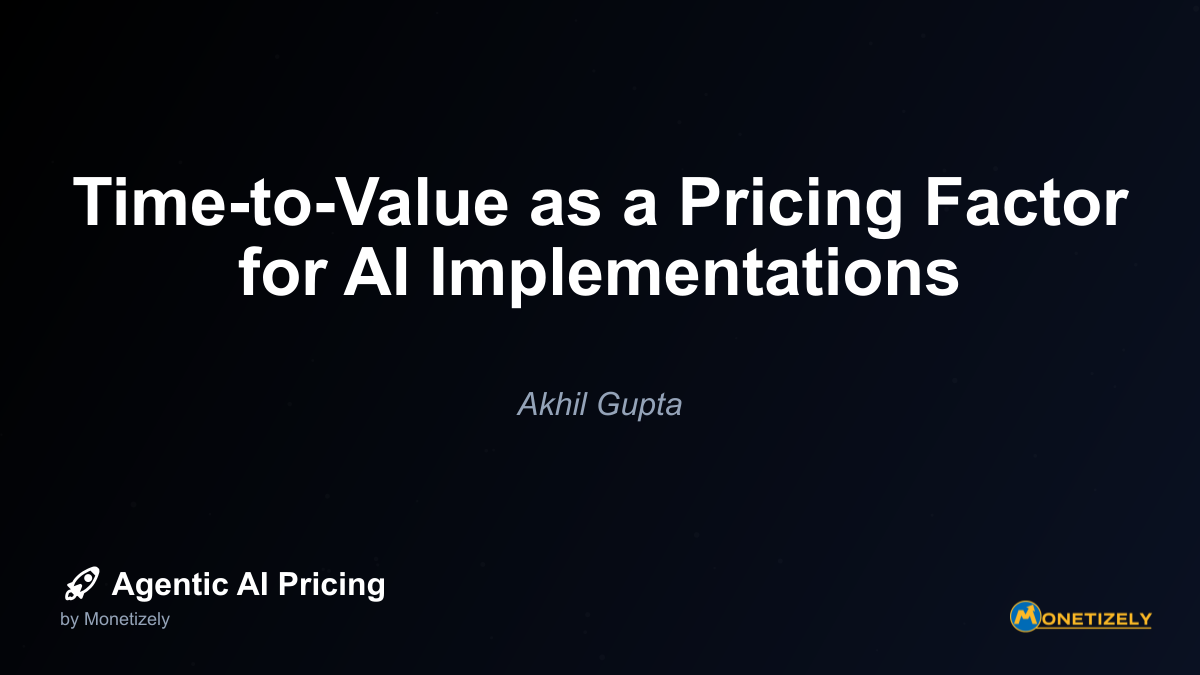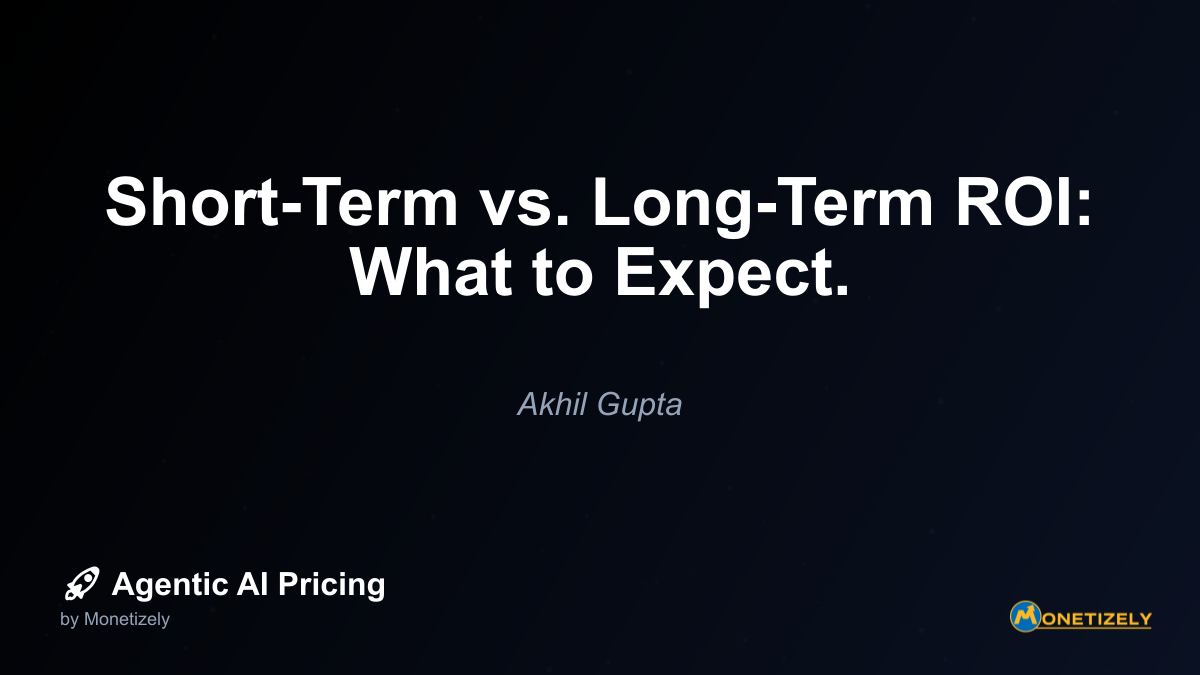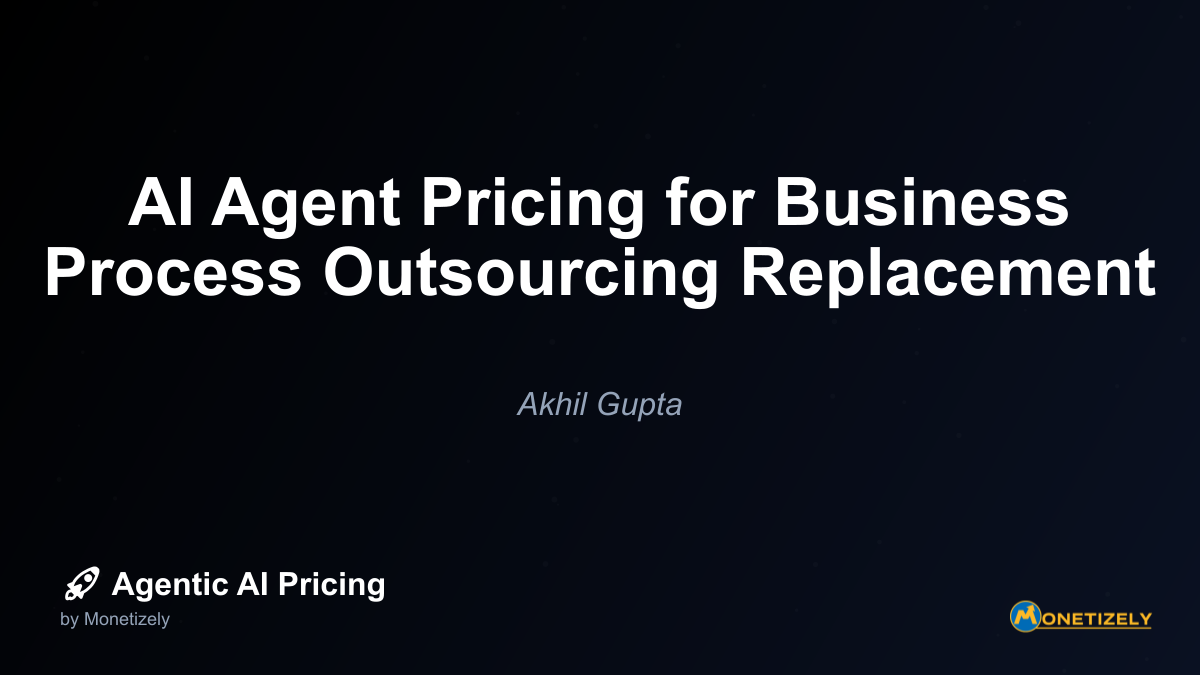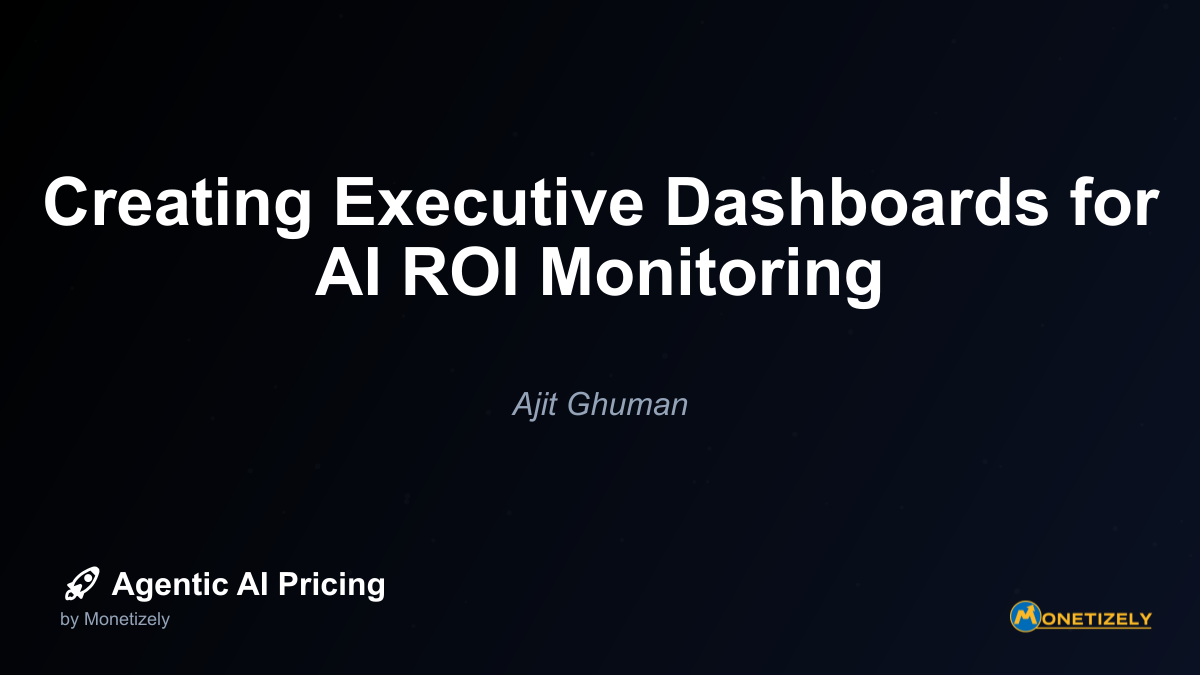· Ajit Ghuman · ROI & Value · 12 min read
The ROI Timeline: When to Expect Returns from Agentic AI Investments
AI and SaaS Pricing Masterclass
Learn the art of strategic pricing directly from industry experts. Our comprehensive course provides frameworks and methodologies for optimizing your pricing strategy in the evolving AI landscape. Earn a professional certification that can be imported directly to your LinkedIn profile.
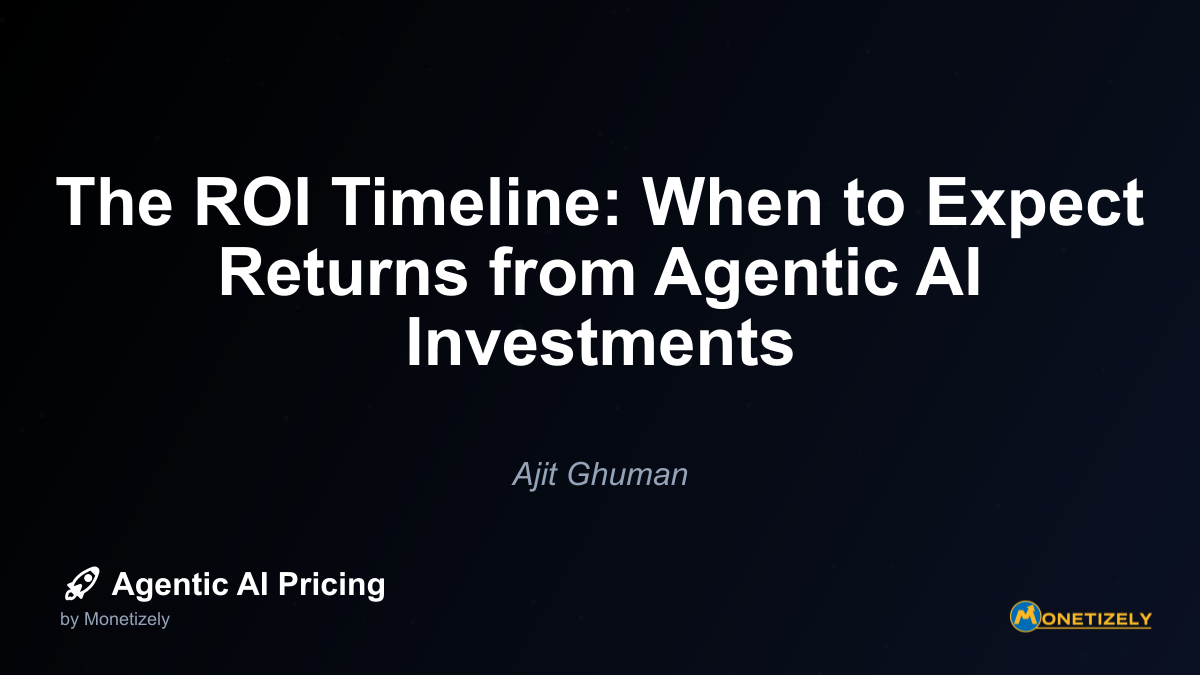
In today’s rapidly evolving technological landscape, agentic AI represents one of the most promising frontiers for business transformation and competitive advantage. However, as with any significant investment, executives and decision-makers are increasingly focused on a critical question: When can we expect to see returns on our agentic AI investments? This comprehensive analysis examines the ROI timeline for agentic AI across industries, providing realistic expectations, benchmarks, and strategies for maximizing returns.
Understanding the ROI Landscape for Agentic AI
Agentic AI—AI systems capable of autonomous decision-making and action—represents a significant evolution beyond traditional AI and even generative AI implementations. Current ROI timelines for these investments typically range from 6 to 18 months, depending on the industry, use case complexity, and implementation approach.
According to recent industry data, companies are projecting substantial returns, with average expected ROI of approximately 171% globally and up to 192% in the U.S. More than 60% of organizations anticipate returns exceeding 100% within this period, highlighting the transformative potential of agentic systems.
However, there’s a notable gap between early pilot enthusiasm and scaled implementation reality. Early generative AI pilots in 2023 reported returns as high as 31% ROI, but as projects scaled, returns often settled to a more typical 7% ROI. This is near or below the average corporate cost of capital (~10%), suggesting that not all implementations deliver immediate financial success. The good news is that top performers achieve up to 18% ROI, indicating that superior results are attainable with maturity and scale.
Industry-Specific ROI Timelines
The timeline for realizing returns on agentic AI investments varies significantly across industries, reflecting differences in operational complexity, regulatory environments, and use case maturity.
Finance and Banking (Fast ROI: under 12-18 months)
The financial sector leads in both adoption speed and ROI realization for agentic AI investments. Several factors contribute to this accelerated timeline:
- Algorithmic trading: By 2025, 75% of equity trades are algorithmically controlled, with agentic AI managing sophisticated strategies responding to real-time data and events
- Risk management automation: Agentic systems provide continuous monitoring and adjustment of risk exposures
- Compliance and regulatory automation: Reducing manual oversight while improving accuracy
A Fortune 500 financial services firm reported a 300% improvement in fraud detection rates after implementing agentic AI assistants that augment human analysts. The company invested 70% of its project budget on training and process redesign rather than just technology, highlighting the importance of organizational change management.
Retail and Customer Service (Moderate-Fast ROI: 12-18 months)
Customer service-intensive industries see relatively quick returns from agentic AI implementations:
- Agentic AI enables intelligent orchestration of customer interactions, managing 85% of interactions end-to-end
- Resolution times decrease by 55% on average
- First-call resolution improves by 78%
H&M’s implementation of a virtual shopping assistant provides a compelling case study, with 70% of queries resolved autonomously, a 25% increase in conversion rates, and 3× faster resolution time. These improvements translated into lower support costs and increased revenue per visitor.
Healthcare (Extended ROI: 18-36 months)
The healthcare sector faces longer ROI timelines due to:
- Complex regulatory environments requiring extensive compliance validation
- Integration challenges with legacy systems and workflows
- Higher stakes for decision-making requiring human oversight
Despite these challenges, a regional healthcare network reported a 60% reduction in administrative costs and significantly faster diagnosis-to-treatment times by combining agentic process automation for administrative tasks with agentic AI supporting diagnostics.
Manufacturing (Extended ROI: 24-36 months)
Manufacturing typically sees longer ROI timelines for agentic AI investments:
- Capital intensity and equipment integration requirements
- Longer operational cycles
- Complex supply chain dependencies
However, the long-term ROI can be substantial through self-optimizing systems, predictive maintenance, and supply chain automation that reduces inventory costs while improving production efficiency.
Key Metrics and Benchmarks for Measuring ROI
Organizations implementing agentic AI are using increasingly sophisticated metrics to track and validate their investments. These metrics fall into several categories:
Financial Metrics
- Percentage ROI: Typical returns range from 7% for average implementations to 18% for top performers
- Operating profit contribution: AI-enabled workflows improved operating profit margins from 2.4% (2022) to 7.7% (2024)
- Cost reduction: Labor savings, reduced error rates, and operational efficiencies
- Revenue growth: Increased conversion rates, higher average order values, and expanded customer lifetime value
Operational Improvements
- Labor productivity: Automation of routine tasks, enabling staff to focus on higher-value activities
- Service quality and accuracy: Improved SLA compliance rates and reduced Mean Time to Resolution (MTTR)
- Process acceleration: Lead conversion times reduced by up to 35%
- Error reduction: Decreased error rates in complex processes
Customer Experience KPIs
- Net Promoter Scores (NPS): Companies expect NPS to increase from 16% in 2024 to 51% by 2026 due to AI personalization
- Customer satisfaction: Improved resolution rates and personalized interactions
- Retention rates: Decreased churn through proactive engagement and issue resolution
Innovation and Market Metrics
- Innovation velocity: Speed of capability deployment
- Time-to-market reductions: Faster product and service launches
- Competitive advantage metrics: Market share gains attributable to AI
Factors Influencing ROI Timeline
Several key factors can accelerate or delay the realization of returns from agentic AI investments:
Implementation Challenges
Complex system integration: Agentic AI systems require integration with existing enterprise infrastructure, which can be difficult if legacy systems are incompatible or lack real-time data capabilities.
Data quality and security: The efficiency of agentic AI depends heavily on high-quality, anomaly-free data. Poor data quality or incomplete datasets reduce system effectiveness and prolong ROI realization.
Cultural and operational shifts: Adoption demands significant organizational change management. Employee resistance due to fears of job loss must be managed through education, training, and communication initiatives.
Managing new systemic risks: Agentic AI brings unique risks such as uncontrolled autonomy, lack of observability, and security vulnerabilities. Building trustable, scalable, and controllable AI requires investment in governance frameworks.
Integration Costs
The total cost of agentic AI implementation extends well beyond the initial technology investment:
- Change management and training: Typically accounts for 20-30% of total project cost
- Data preparation and integration: Ensuring high-quality inputs for AI systems
- Ongoing maintenance and optimization: Continuous improvement of AI models and workflows
- Compliance and governance: Establishing frameworks for responsible AI use
Success Factors
Organizations that achieve faster ROI typically demonstrate several common characteristics:
Clear KPIs and continuous oversight: Defining measurable goals and monitoring them consistently
Prior GenAI experience: Companies familiar with generative AI tend to adopt agentic AI faster due to a shortened learning curve
Strategic alignment: Ensuring agentic AI initiatives directly support core business objectives
Agility and vendor-agnostic architectures: Maintaining flexibility to adapt to the rapidly evolving AI landscape
Case Studies: Successful ROI Achievement
Several organizations have reported successful ROI from agentic AI investments, providing valuable insights into effective implementation strategies:
Fortune 500 Financial Services
Strategy: Focused on augmenting fraud analysts with AI assistants that learn over time and improve fraud pattern detection.
Results: 300% improvement in fraud detection rates without layoffs; invested 70% of budget on training & process redesign.
Timeline: ROI achieved within 18 months.
Major Banking Institution
Strategy: Implemented an agentic CRM platform to personalize customer engagement at scale with AI-driven segmentation, message crafting, and automated outreach integrated with Salesforce and HubSpot.
Results: 25% increase in conversion rates, 30% boost in customer satisfaction, 40% shorter sales cycles, 20% better retention, and 15% fewer complaints.
Timeline: Full ROI realized within 12 months.
National Financial Group Wealth Advisory
Strategy: Deployed agentic AI agents that process market data and client milestones to dynamically advise portfolios with explainability.
Results: 40% increase in client retention, $200M growth in assets under management.
Timeline: 18-month period through 2025.
H&M (Retail)
Strategy: Implemented a virtual shopping assistant providing personalized product recommendations and faster query resolutions.
Results: 70% of queries resolved autonomously, 25% increase in conversion rates, 3× faster resolution time.
Timeline: ROI achieved within 12-18 months.
Best Practices for Accelerating ROI
To accelerate returns from agentic AI investments, organizations should consider the following best practices:
Strategic Program Approach
Rather than pursuing scattered pilots, adopt a strategic program approach that ties agentic AI initiatives explicitly to critical business goals such as operational efficiency, revenue growth, compliance, or customer intimacy.
Transform Entire Business Processes
Embed agentic AI agents throughout workflows rather than applying AI to discrete steps. Aim for agents handling 60% of a function, which drives broader organizational impact and accelerates returns.
Start with Proven, High-Impact Use Cases
Begin with well-established use cases such as autonomous financial trading, intelligent customer service orchestration, or automated contract processing to get quick wins that build momentum.
Scale Systematically and Rapidly
Move quickly from pilots to enterprise-wide deployment, since firms at scale achieve up to 400% greater financial returns compared to pilots.
Build a Compelling Business Case
Develop a realistic, quantified business case with pilot results early to secure funding and stakeholder support for broader implementation.
Common Pitfalls to Avoid
Several common mistakes can delay or diminish ROI from agentic AI investments:
Superficial Automation
Relying on isolated AI automation (e.g., chatbots only) that fails to deliver meaningful business impact.
Underestimating Hidden Costs
Failing to account for change management, training, data integration, ongoing maintenance, and compliance costs.
Insufficient Measurement
Lacking rigorous, continuous measurement and adjustment of ROI, which prevents optimization of AI initiatives.
Poor Strategic Alignment
Pursuing scattered projects with limited or no impact on critical KPIs and overall business value.
The ROI Timeline Framework
Based on extensive research and industry benchmarks, we propose the following framework for understanding and planning the ROI timeline for agentic AI investments:
Phase 1: Initial Implementation (0-6 months)
Focus: Technology deployment, integration, and initial training. Expected Returns: Minimal direct financial returns; focus on operational metrics and early adoption. Key Metrics: Implementation milestones, user adoption rates, system performance.
Phase 2: Early Value Capture (6-12 months)
Focus: Process optimization, expanding use cases, refining AI models. Expected Returns: Initial cost savings, productivity improvements, and process acceleration. Key Metrics: Operational efficiency gains, error reduction, time savings.
Phase 3: Business Impact (12-24 months)
Focus: Scaling successful implementations, deeper integration with core business processes. Expected Returns: Substantial cost savings, revenue enhancement, and competitive differentiation. Key Metrics: Financial ROI, customer experience improvements, market share gains.
Phase 4: Transformative Value (24+ months)
Focus: Business model innovation, new product/service development, ecosystem expansion. Expected Returns: Strategic differentiation, new revenue streams, industry leadership. Key Metrics: Long-term growth, market positioning, innovation metrics.
Industry-Specific ROI Timeline Benchmarks
Based on current research and case studies, here are the typical ROI timelines by industry:
| Industry | ROI Timeline | Key Drivers for ROI | Notes |
|---|---|---|---|
| Finance | < 12-18 months | Algorithmic trading, risk management, compliance automation | Fast decision cycles, direct revenue impact |
| Retail/Customer Service | 12-18 months | End-to-end customer interaction automation | Cost savings + improved retention & customer satisfaction |
| Healthcare | 18-36 months | Diagnostics, patient monitoring, admin automation | Regulatory hurdles, integration with legacy systems |
| Manufacturing | 24-36 months | Self-optimizing systems, supply chain automation | Capital intensity, longer operational cycles |
| Others (e.g., Telecom, Marketing) | 12-24 months | Lead conversion, sales prioritization, personalization | Highly dynamic environments benefiting from agentic responsiveness |
Future Trends in Agentic AI ROI (2025-2030)
Looking ahead, several important trends will shape the ROI landscape for agentic AI investments:
Accelerating ROI Timelines
Companies should anticipate ROI timelines for agentic AI investments to increasingly accelerate from 2025 through 2030, with some enterprises realizing significant returns within the first year of deployment. This acceleration will be driven by:
- Increasing maturity and standardization of agentic AI technologies
- Greater ecosystem investments by hyperscalers and digital transformation leaders
- More pre-built solutions reducing implementation time and cost
Market Growth and Adoption
The agentic AI market is expected to grow from $7 billion in 2025 to over $90 billion by 2032, at a compound annual growth rate (CAGR) above 40%. This reflects widespread enterprise adoption and system-wide integration that will create more established patterns for ROI realization.
Faster Time-to-ROI
Some enterprises report average revenue increases of around 15% within the first year of implementing agent-based AI, alongside operational cost savings up to 30% and improved customer satisfaction metrics by 25%. Mature agentic AI solutions enable value capture 4–5 times faster than less-developed custom solutions.
Governance and Risk Management
By 2025, companies are expected to systematize AI governance and risk controls to sustain value and maintain trust. While this may impact deployment speed and add compliance costs, it will ensure longer-term ROI reliability by preventing costly failures or regulatory issues.
Potential Challenges
Up to 40% of agentic AI projects could fail or be canceled by the end of 2027 due to unclear business cases, escalating costs, or insufficient risk controls. This emphasizes the need for rigorous planning and execution to ensure ROI realization.
Strategic Recommendations for Maximizing ROI
Based on our analysis, we recommend the following strategies to maximize ROI from agentic AI investments:
1. Adopt a Value-First Approach
Begin with a clear understanding of the business value you aim to create through agentic AI. Define specific, measurable outcomes that align with strategic priorities.
2. Prioritize Use Cases by ROI Potential
Evaluate potential use cases based on their expected ROI timeline, implementation complexity, and strategic importance. Focus initial efforts on high-impact, lower-complexity opportunities.
3. Build a Robust Measurement Framework
Develop a comprehensive framework for measuring both financial and non-financial returns from agentic AI investments. Include leading indicators that can predict long-term ROI.
4. Invest in Organizational Readiness
Allocate sufficient resources to change management, training, and organizational alignment. Remember that up to 70% of successful implementations’ budgets go toward these non-technical aspects.
5. Plan for Iterative Scaling
Design your implementation approach to move quickly from pilots to scaled deployment. Establish clear criteria for scaling decisions based on early ROI indicators.
6. Develop an AI Governance Framework
Create a governance structure that balances innovation with appropriate risk management. This will prevent costly missteps while enabling the agility needed for successful implementation.
7. Cultivate Internal AI Expertise
Build internal capabilities rather than relying exclusively on external vendors. This creates a sustainable competitive advantage and improves long-term ROI.
Conclusion: Realistic Expectations and Strategic Planning
The ROI timeline for agentic AI investments varies significantly based on industry, use case, and implementation approach. While some organizations achieve returns within 6-12 months, others may require 24-36 months to realize full value.
To maximize returns and accelerate the ROI timeline, organizations should:
- Align agentic AI initiatives with strategic business objectives
- Focus on transforming end-to-end business processes rather than isolated tasks
- Begin with high-impact use cases that demonstrate clear value
- Invest sufficiently in organizational change management and training
- Establish robust measurement frameworks to track and optimize returns
- Scale successful implementations rapidly to capture enterprise-wide value
By taking a strategic, measured approach to agentic AI investments, organizations can navigate the ROI timeline effectively and realize substantial returns from this transformative technology.
As the agentic AI landscape continues to evolve, those who establish effective implementation patterns, governance frameworks, and measurement practices will be best positioned to achieve sustainable competitive advantage through faster and more substantial returns on their investments.
For organizations considering or currently implementing agentic AI, the key to success lies in realistic expectations coupled with strategic planning and disciplined execution. By understanding the typical ROI timeline for your industry and use cases, you can set appropriate benchmarks and milestones while building the organizational capabilities needed to accelerate returns.
For a comprehensive approach to measuring ROI for AI agent implementations, we recommend exploring our detailed blog post
Co-Founder & CEO
Ajit is the author of Price To Scale, a top book on SaaS Pricing and is the Founder of Monetizely. Ajit has led and worked in pricing and product marketing at firms like Twilio, Narvar and Medallia. His work has been featured in Forbes and VentureBeat. Ajit regularly consults with software companies from Seed stage to post-IPO on pricing strategy. Ajit is also a highly-rated co-instructor for 'The Art of SaaS Pricing and Monetization' on Maven.
Pricing Strategy Audit
Let our experts analyze your current pricing strategy and identify opportunities for improvement. Our data-driven assessment will help you unlock untapped revenue potential and optimize your AI pricing approach.

